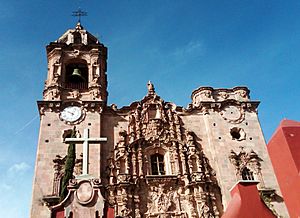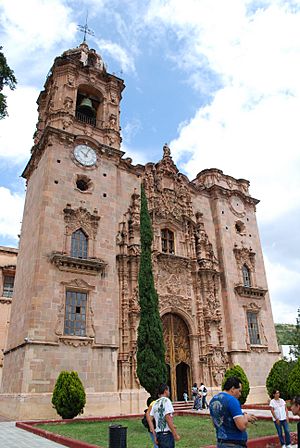La Valenciana Church (San Cayetano) facts for kids
Quick facts for kids La Valenciana Church |
|
|---|---|
|
Iglesia de la Valenciana (Spanish)
|
|

La Valenciana Church
|
|
| Denomination | Catholic |
| Tradition | Roman Rite |
| History | |
| Dedication | Saint Cajetan |
| Architecture | |
| Style | Churrigueresque |
| Groundbreaking | 1775 |
| Completed | 1788 |
| Administration | |
| Archdiocese | León |
The La Valenciana Church, also known as the San Cayetano Church, is a beautiful church from the 1700s in Mexico. It stands right at the entrance to the La Valenciana mine, where the biggest discovery of silver in Mexico was made.
The church was built by the mine's owner, Antonio de Ordóñez y Alcocer. He built it to thank his favorite saint, Saint Cajetan, for the incredible wealth the mine brought him. Inside, the church is famous for its amazing decorations covered in real gold leaf. Today, it is also a location for the famous Festival Internacional Cervantino, an international arts festival.
Contents
A Tour of the Church
The church is located on a hill overlooking the city of Guanajuato. It is a fantastic example of a very detailed and fancy style of art called Mexican Churrigueresque.
Stunning Exterior
The outside of the church is made from a pink volcanic stone called cantera. The walls around the main entrance are covered in detailed carvings that look like outdoor altars. The main doors are made of beautifully carved wood, which was a popular style at the time. The church is surrounded by a wall with special tops called merlons, which look like the top of a castle wall.
Golden Interior
Inside, the church is shaped like a Latin cross. Where the long and short parts of the cross meet, there is a beautiful eight-sided dome called a cupola. The most amazing feature is the three huge altarpieces at the front. An altarpiece is a work of art set up behind an altar. These are completely covered in shiny gold leaf. The main one is dedicated to Saint Cajetan.
The church still has some of its original furniture, like the fancy speaker's stand (called a pulpit) and the organ. There are also several large paintings from the late 1800s. A building connected to the church holds historical records for the University of Guanajuato.
History of the Church
The La Valenciana Church is one of several churches in Guanajuato built near the entrance to a mine. It was a way for mine owners to show their thanks for their good fortune.
The Richest Silver Mine
The La Valenciana mine was first opened in 1558 but was quickly closed because people thought all the silver was gone. Many years later, in 1760, a man named Antonio de Ordóñez y Alcocer decided to try again. He dug 80 meters down and discovered the largest silver vein ever found in Mexico!
This discovery made Antonio incredibly rich. He became so important that the King of Spain, Carlos III, gave him a noble title in 1780. He became the Count of La Valenciana.
Building a Masterpiece
To show his gratitude, Antonio decided to fund the building of the church. Construction began in 1775. Sadly, the first architect and master carpenter both passed away before the church was finished. New experts took over and completed the project in 1788.
Antonio's family also planned to build a home for monks next to the church, but it was never used. Over the years, the church has lost one of its bell towers and some of the statues on its front. There have been some worries about protecting the church from damage caused by water and dust.
See also
 In Spanish: Iglesia de la Valenciana para niños
In Spanish: Iglesia de la Valenciana para niños
- List of buildings in Guanajuato City


